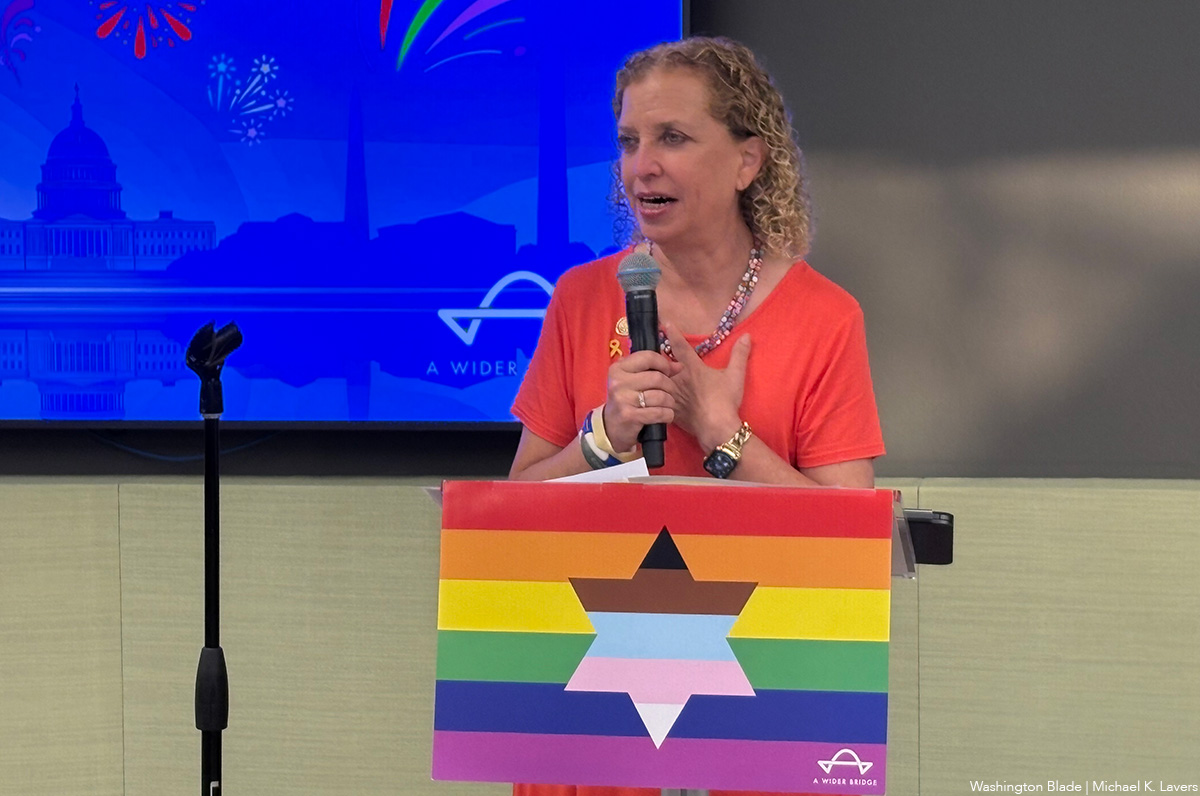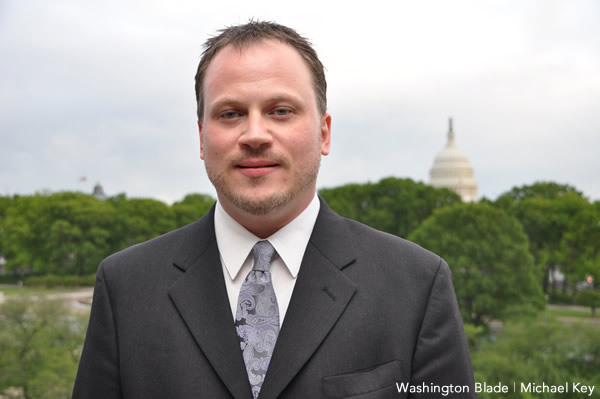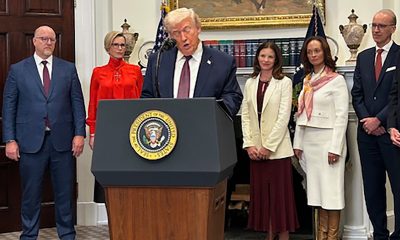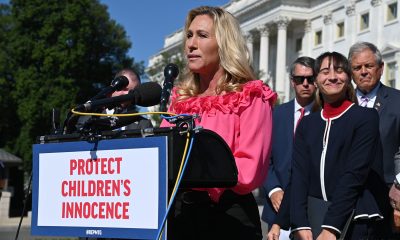National
EXCLUSIVE: National Stonewall Democrats faces $30,000 budget gap
Organization ‘will likely be forced to close our doors’ if it doesn’t raise money by Dec. 31

The Washington Blade has obtained an e-mail that indicates National Stonewall Democrats will likely shut down if it does not close a $30,000 budget gap by Dec. 31.
“It’s no secret that we’ve struggled with fundraising over the past few years, but today we are at a crossroads and we’re turning to you – our members and supporters,” wrote Jerame Davis, the group’s executive director, in an e-mail he will send to his organization’s e-mail list later on Wednesday. “As the year closes, we’re facing a budget deficit of over $30,000 and if we do not bridge this gap, we will likely be forced to close our doors.”
Davis told the Blade in an exclusive interview on Tuesday night the National Stonewall Democrats’ 2012 budget is between $130,000-$140,000. This figure includes up to $40,000 in organizational debt he inherited when he became executive director in Dec. 2011.
Internal Revenue Service documents indicate the organization reported $223,202 in revenue, while spending $253,133 (a deficit of $19,931) in 2011. These figures were $305,745 and $328,803 (a deficit of $23,058) in 2010 and $346,679 and $425,927 (a deficit of $79,248) in 2009 respectively.
Davis said fundraising picked up “quite a bit” at the beginning of the year – an April fundraiser in D.C. that honored gay Massachusetts Congressman Barney Frank, who founded National Stonewall Democrats in 1998, raised nearly $70,000. Davis said the organization was debt-free by the end of July, but it spent roughly $20,000 at the Democratic National Convention in Charlotte in September.
“In doing so we kind of depleted our reserves hoping that we would come out the other side with some fundraising momentum out of that,” he said. “Instead, quite the opposite happened. The campaigns started heating up so a lot of the fundraising started shifting towards President Obama and towards Tammy Baldwin and we took a hit fast and having no reserves coming out of the convention it kind of snowballed to where we are now.”
Organization received anonymous $100,000 donation in 2011
This is not the first time National Stonewall Democrats’ financial problems have threatened to shutter the organization.
The Blade reported in Feb. 2011 that an anonymous donor gave $100,000 to National Stonewall Democrats amid reports then-Executive Director Michael Mitchell did not effectively manage the group’s budget. Davis said the organization was “kind of back in the same boat when I took over” in Nov. 2011 after Mitchell stepped down.
“When I took over the organization, there was $1,800 in the bank and a boat load of debt,” he said. “We were facing eviction from our office; I mean there were all kinds of problems that I had to tackle. I had payroll to make two weeks after I took over and $1,800 in the bank and no donors and that was in November last year, the worst time for a 501c4 to be fundraising.”
Davis noted 2008 was his organization’s best year in terms of fundraising when its budget nearly topped $700,000. IRS records indicate National Stonewall Democrats reported $465,391 in revenue and $435,946 in expenses that year.
A changing political landscape, however, began to take its toll.
“We didn’t adapt to that, especially with the election of President Obama in 2008,” said Davis.
Melissa Sklarz, who co-chaired National Stonewall Democrats Board of Directors from 2009 through early 2011, noted then-President Bill Clinton had signed the ban on openly gay servicemembers and the Defense of Marriage Act into law in the years before Frank created the organization.
“It’s a very different Democratic party,” she told the Blade. “It’s a very different America. So maybe people feel they don’t need to go through national Stonewall. It’s mostly internal.”
The departure of Mitchell and two other executive directors before him has also had an adverse impact on the organization’s ability to raise money.
“That’s a big part of the problem, that kind of turnover, but also decisions that were made in that time, directions the organization took for its messaging, the directions that our programs took, some of them lost their bang so to speak,” said Davis. “We didn’t develop a lot of new programs that appeal to folks. Our fundraising took a hit as a result.”
The latest revelation about National Stonewall Democrats’ uncertain future comes less than a month after Obama, who endorsed marriage rights for same-sex couples in May, won re-election. Wisconsin Congressman Tammy Baldwin became the first openly gay U.S. senator-elect; while gay U.S. Reps. David Cicilline (D-R.I.) and Jared Polis (D-Colo.) won re-election. Voters in New York, California, Wisconsin and Arizona also elected openly gay and bisexual congressional candidates.
The Gertrude Stein Democratic Club in D.C., the Virginia Partisans Gay and Lesbian Democratic Club and the Barbara Gittings Delaware Stonewall Democrats are three of the more than 80 chapters and affiliates throughout the country.
Davis, who has remained National Stonewall Democrats’ only full-time staffer since shortly after he became the group’s executive director, said expenses have been cut to about $10,000 a month. He stressed his organization remains relevant.
“There are a number of state and local Democratic parties that aren’t on board with LGBT equality,” said Davis. “Some of whom are still outwardly hostile in some of the red states and more conservative states. And in a lot of ways its those areas where LGBT equality really hasn’t caught on; the places like Indiana, the places like Alabama, the places like Kentucky. That’s where we really need to do the work because they’re the ones holding us back. It’s the lack of a strong Democratic party, the lack of a strong pro-LGBT party that even the Democrats who are elected from these areas aren’t necessarily fully on board with full LGBT equality.”
He added grassroots organizing among Democrats in the aforementioned states is one of the many ways where “we excel.”
“Our clubs and our affiliates they have special relationships with their local elected leaders because they’re the ones that are out there knocking on doors and raising money and stuffing envelopes and making phone calls for these candidates,” said Davis. “On a national level we have to help coordinate that work, we have to help expand.”
National Stonewall Democrats Board Co-Chair Stephen Driscoll agreed.
“The stuff we do is grassroots, our mission has always been to make the Democratic Party better on our issues,” he said, while acknowledging what he described as ineffective organizational leadership before Davis’ tenure as a contributing factor to National Stonewall Democrats’ current financial situation. “There is no question that we have done that, especially in the national party and in many state orgs around the country we still have a lot of work to do in those diminishing number of states that are less than supportive on LGBT issues.”
“There’s still lots of work to be done in the national legislative arena,” added Sklarz. “National Stonewall is the perfect organization for that. HRC [the Human Rights Campaign] has its niche and Victory Fund has theirs and national Stonewall’s is to elect pro-equality Democrats. And there are lots of places, there is lots of room.”

A Wider Bridge on Friday announced it will shut down at the end of the month.
The group that “mobilizes the LGBTQ community to fight antisemitism and support Israel and its LGBTQ community” in a letter to supporters said financial challenges prompted the decision.
“After 15 years of building bridges between LGBTQ communities in North America and Israel, A Wider Bridge has made the difficult decision to wind down operations as of Dec. 31, 2025,” it reads.
“This decision comes after challenging financial realities despite our best efforts to secure sustainable funding. We deeply appreciate our supporters and partners who made this work possible.”
Arthur Slepian founded A Wider Bridge in 2010.
The organization in 2016 organized a reception at the National LGBTQ Task Force’s Creating Change Conference in Chicago that was to have featured to Israeli activists. More than 200 people who protested against A Wider Bridge forced the event’s cancellation.
A Wider Bridge in 2024 urged the Capital Pride Alliance and other Pride organizers to ensure Jewish people can safely participate in their events in response to an increase in antisemitic attacks after Hamas militants attacked Israel on Oct. 7, 2023.
The Jewish Telegraphic Agency reported authorities in Vermont late last year charged Ethan Felson, who was A Wider Bridge’s then-executive director, with lewd and lascivious conduct after alleged sexual misconduct against a museum employee. Rabbi Denise Eger succeeded Felson as A Wider Bridge’s interim executive director.
A Wider Bridge in June honored U.S. Rep. Debbie Wasserman Schultz (D-Fla.) at its Pride event that took place at the Capital Jewish Museum in D.C. The event took place 15 days after a gunman killed two Israeli Embassy employees — Yaron Lischinsky and Sarah Milgrim — as they were leaving an event at the museum.
“Though we are winding down, this is not a time to back down. We recognize the deep importance of our mission and work amid attacks on Jewish people and LGBTQ people – and LGBTQ Jews at the intersection,” said A Wider Bridge in its letter. “Our board members remain committed to showing up in their individual capacities to represent queer Jews across diverse spaces — and we know our partners and supporters will continue to do the same.”
Editor’s note: Washington Blade International News Editor Michael K. Lavers traveled to Israel and Palestine with A Wider Bridge in 2016.
The White House
‘Trump Rx’ plan includes sharp cuts to HIV drug prices
President made announcement on Friday

President Donald Trump met with leaders from some of the world’s largest pharmaceutical companies at the White House on Friday to announce his new “Trump Rx” plan and outline efforts to reduce medication costs for Americans.
During the roughly 47-minute meeting in the Roosevelt Room, Trump detailed his administration’s efforts to cut prescription drug prices and make medications more affordable for U.S. patients.
“Starting next year, American drug prices will come down fast, furious, and will soon be among the lowest in the developed world,” Trump said during the meeting. “For decades, Americans have been forced to pay the highest prices in the world for prescription drugs by far … We will get the lowest price of anyone in the world.”
Trump signed an executive order in May directing his administration “to do everything in its power to slash prescription drug prices for Americans while getting other countries to pay more.”
“This represents the greatest victory for patient affordability in the history of American health care, by far, and every single American will benefit,” he added.
Several pharmaceutical executives stood behind the president during the announcement, including Sanofi CEO Paul Hudson, Novartis CEO Vas Narasimhan, Genentech CEO Ashley Magargee, Boehringer Ingelheim (USA) CEO Jean-Michel Boers, Gilead Sciences CEO Dan O’Day, Bristol Myers Squibb General Counsel Cari Gallman, GSK CEO Emma Walmsley, Merck CEO Robert Davis, and Amgen Executive Vice President Peter Griffith.
Also in attendance were Health and Human Services Secretary Robert F. Kennedy Jr., Commerce Secretary Howard Lutnick, Centers for Medicare and Medicaid Services Administrator Mehmet Oz, and Food and Drug Administration Commissioner Marty Makary.
Under the Trump Rx plan, the administration outlined a series of proposed drug price changes across multiple companies and therapeutic areas. Among them were reductions for Amgen’s cholesterol-lowering drug repatha from $573 to $239; Bristol Myers Squibb’s HIV medication reyataz from $1,449 to $217; Boehringer Ingelheim’s type 2 diabetes medication jentadueto from $525 to $55; Genentech’s flu medication xofluza from $168 to $50; and Gilead Sciences’ hepatitis C medication epclusa from $24,920 to $2,425.
Additional reductions included several GSK inhalers — such as the asthma inhaler advair diskus 500/50, from $265 to $89 — Merck’s diabetes medication januvia from $330 to $100, Novartis’ multiple sclerosis medication mayzent from $9,987 to $1,137, and Sanofi’s blood thinner plavix from $756 to $16. Sanofi insulin products would also be capped at $35 per month’s supply.
These prices, however, would only be available to patients who purchase medications directly through TrumpRx. According to the program’s website, TrumpRx “connects patients directly with the best prices, increasing transparency, and cutting out costly third-party markups.”
Kennedy spoke after Trump, thanking the president for efforts to lower pharmaceutical costs in the U.S., where evidence has shown that drug prices — including both brand-name and generic medications — are nearly 2.78 times higher than prices in comparable countries. According to the Pharmaceutical Research and Manufacturers of America, roughly half of every dollar spent on brand-name drugs goes to entities that play no role in their research, development, or manufacturing.
“This is affordability in action,” Kennedy said. “We are reversing that trend and making sure that Americans can afford to get the life-saving solutions.”
Gilead CEO Dan O’Day also spoke about how the restructuring of drug costs under TrumpRx, combined with emerging technologies, could help reduce HIV transmission — a virus that, if untreated, can progress to AIDS. The LGBTQ community remains disproportionately affected by HIV.
“Thank you, Mr. President — you and the administration,” O’Day said. “I think this objective of achieving the commitment to affordability and future innovation is extraordinary … We just recently launched a new medicine that’s only given twice a year to prevent HIV, and we’re working with Secretary Kennedy and his entire team, as well as the State Department, as a part of your strategy to support ending the epidemic during your term.
“I’ve never been more optimistic about the innovation that exists across these companies and the impact this could have on America’s health and economy,” he added.
Trump interjected, asking, “And that’s working well with HIV?”
“Yes,” O’Day replied.
“It’s a big event,” Trump said.
“It literally prevents HIV almost 100 percent given twice a year,” O’Day responded.
A similar anti-HIV medication is currently prescribed more than injectable form mentioned by O’Day. PrEP, is a medication regimen proven to significantly reduce HIV infection rates for people at high risk. Without insurance, brand-name Truvada can cost roughly $2,000 per month, while a generic version costs about $60 per month.
Even when medication prices are reduced, PrEP access carries additional costs, including clinic and laboratory fees, office visits, required HIV and sexually transmitted infection testing, adherence services and counseling, and outreach to potentially eligible patients and providers.
According to a 2022 study, the annual total cost per person for PrEP — including medication and required clinical and laboratory monitoring — is approximately $12,000 to $13,000 per year.
The TrumpRx federal platform website is now live at TrumpRx.gov, but the program is not slated to begin offering reduced drug prices until January.
The White House
EXCLUSIVE: Democracy Forward files FOIA lawsuit after HHS deadnames Rachel Levine
Trans former assistant health secretary’s name changed on official portrait

Democracy Forward, a national legal organization that works to advance democracy and social progress through litigation, policy and public education, and regulatory engagement, filed a lawsuit Friday in federal court seeking to compel the U.S. Department of Health and Human Services to release information related to the alteration of former Assistant Secretary for Health Adm. Rachel Levine’s official portrait caption.
The lawsuit comes in response to the slow pace of HHS’s handling of multiple Freedom of Information Act requests — requests that federal law requires agencies to respond to within 20 working days. While responses can take longer due to backlogs, high request volumes, or the need for extensive searches or consultations, Democracy Forward says HHS has failed to provide any substantive response.
Democracy Forward’s four unanswered FOIA requests, and the subsequent lawsuit against HHS, come days after someone in the Trump-Vance administration changed Levine’s official portrait in the Hubert H. Humphrey Building to display her deadname — the name she used before transitioning and has not used since 2011.
According to Democracy Forward, HHS “refused to release any records related to its morally wrong and offensive effort to alter former Assistant Secretary for Health Admiral Rachel Levine’s official portrait caption.” Levine was the highest-ranking openly transgender government official in U.S. history and served as assistant secretary for health and as an admiral in the U.S. Public Health Service Commissioned Corps from 2021 to 2025.
Democracy Forward President Skye Perryman spoke about the need to hold the Trump-Vance administration accountable for every official action, especially those that harm some of the most targeted Americans, including trans people.
“The question every American should be asking remains: what is the Trump-Vance administration hiding? For an administration that touts its anti-transgender animus and behavior so publicly, its stonewalling and silence when it comes to the people’s right to see public records about who was behind this decision is deafening,” Perryman said.
“The government’s obligation of transparency doesn’t disappear because the information sought relates to a trailblazing former federal official who is transgender. It’s not complicated — the public is entitled to know who is making decisions — especially decisions that seek to alter facts and reality, erase the identity of a person, and affect the nation’s commitment to civil rights and human dignity.”
“HHS’s refusal to respond to these lawful requests raises more serious concerns about transparency and accountability,” Perryman added. “The public has every right to demand answers — to know who is behind this hateful act — and we are going to court to get them.”
The lawsuit also raises questions about whether the alteration violated federal accuracy and privacy requirements governing Levine’s name, and whether the agency improperly classified the change as an “excepted activity” during a lapse in appropriations. By failing to make any determination or produce any records, Democracy Forward argues, HHS has violated its obligations under federal law.
The case, Democracy Forward Foundation v. U.S. Department of Health and Human Services, was filed in the U.S. District Court for the District of Columbia. The legal team includes Anisha Hindocha, Daniel McGrath, and Robin Thurston.
The Washington Blade reached out to HHS, but has not received any comment.
The lawsuit and four FOIA requests are below:




















